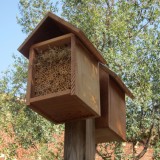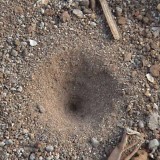
Another wasp colony, this one on our shed, probably related to the destroyed colony. It’s a little blurry because I had no desire to get up in their business to take a better photo.
Stinging insects tend to send people into panic, especially if they’re yellow and black striped. After years of keeping bees, we’ve come to learn that many people can’t distinguish a honey bee from a yellow jacket from a wasp–and we won’t even start on the native bees. Yet it pays to be able to do so, because each is quite different, and we can interact peaceably with all of them if we know their ways.
Paper wasps, also called umbrella wasps, are those guys who build smallish, open celled nests in protected places, often the eaves of your house. Wasp stings are quite painful, but few people know that these wasps rarely attack unless provoked. More, they are very beneficial in the garden, because they prey on insects which damage plants. So when they build nests under our eaves, we leave them alone, and never have any problems.
But keep in mind that they do have excellent facial recognition abilities, so if you ever hassle them (say with a hose set to the jet setting) they may not forget you so quickly.
With wasps, it pays to be diplomatic.
Unless you are a scrub jay.

Western scrub jay, courtesy Wikimedia
I saw this amazing drama earlier this week. I wish I could have captured it on film. We had a small wasp nest in the corner of our patio roof. From my place on the living room sofa, I could see this corner through the front door. One fine morning a bold western scrub jay came to rest on our porch railing, then swooped upward and plucked a wasp off the nest and gobbled it up.
I was very impressed. I had no idea they ate wasps.
She ate a second wasp, delicately picking it apart on the railing, looking very self-satisfied. I thought the show was over, but it turns out she was just enjoying appetizers, because next she launched up and took the entire nest in her beak–random wasps still attached– and flapped off with it into the clear blue sky. Perhaps to enjoy the creamy center in privacy–or perhaps to feed her babies?
One wasp returned to sit forlornly in the place where the nest used to be.
I don’t often use the term bad ass, but that was bad ass.
And the moral? If you don’t want paper wasps in your eaves, do your best to attract birds to your yard. Especially brassy thieves like jays.
Here is a little bit more on paper wasps from the ever-useful Xerces society.




So is a yellow jacket the same thing as a paper/umbrella wasp? Very interesting fact regarding their ability for facial recognition. Reminds me of crow’s ability to do that. Thanks.
No. Yellow jackets are different. Google some pics, and you’ll see. Wasps have that distinctive “wasp waist”. Yellow jackets are shaped more like honey bees, but are bold black and yellow, instead of the fuzzy goldish brown and black of honeybees. Some yellow jackets live in nests the ground (others might build nests?). Yellow jackets are the classic picnic pest, because they like meat.
From reading the Xerces society article, I think that paper wasps can recognize other WASPS from their facial markings, not people, although I could be wrong.
Apparently, not only can crows recognize individual humans but they can tell other crows about you. If you upset a crow, the crows for miles around will find out and treat you as an enemy. Eventually, you will have to move house, but the chances are the crows in your new place will already know about you. It pays to be kind to crows!
Yes, but I figured if they could recognize each other, they could recognize us. Be kind to crows–and never underestimate wasps! 😉
That is very bad ass!! I am gonna post on Facebook, where I am known for forcing my love of nature on people. I am also going to have to google pics of the various insects. I am in the lower midwest, and we have mud daubers, which have a very narrow segment in their midsection, which distinguishes these harmless insects from what we call red wasps, whose sting really really really hurts. The red wasps don’t have a narrow waist, so maybe there aren’t really wasps. I also have the wasps that build the open celled nests.
I LOVE this story!
BAM!! Totally Bad Ass Scrub Jay! That’s pretty fierce…
hhmmmm…interesting about the possible facial recognition….i have been lucky to have never been stung by a wasp and have always found them graceful and polite….in fact, they wait for me to fill the bird bath and land and drink….also, they seem to like a very fine mist on hot days…..never troubled me….but they don’t seem to like my husband who has been known to smack the lawn mower into the clothes pole where some of them live…..so maybe they recognize him from me and “bug” him. cool.
Ah. I knew there was a good reason I was making Steve knock down the wasp nests as they get built instead of doing it myself (aside from the fact that he can reach them and I can’t).
Even though we have several hundred feet of eaves, the wasps always build their nest right over the sliding glass door, which is the door we use the most. They never build it anywhere else on the house. I would love it if you could explain why they do that.
The only wasp nest I have seen this year was right over the door I use to go in and out of the house.
I lived in a mobile home for a while as a kid. Paper wasps LOVE to build nests in the corrugated sides of a mobile home. We could hear their hum off and on throughout the summer, and it was actually very soothing and relaxing. I’ve been much more relaxed and gentle about stinging insects in general ever since, and have only been stung once (I sat down on a bench without looking and leaned back on the wasp–so totally fair, I’d sting if I was being squished, too!).
I nominate this post for “post of the year 2015”. Educational and made me laugh out loud.
Eastern Yellowjackets will sometimes build their nests under house siding. One way of deterring them is to plug up the access hole with steel wool. You should only do this when they are starting to build the nest. There have been cases when people have done this with fully operational nests and the reaction of the trapped wasps has been to bite their way through sheetrock and emerge inside the house. This seems entirely reasonable to me.
We sometimes get wasps in our house – I figured they were coming in thru loose fitting windows, but maybe there is another access point. We haven’t plugged up any access holes. Last fall, as the temps began to drop, I opened up the wood stove only to find a gathering of about 20 wasps on the door. I nearly fainted. Thankfully they were very slow moving in the cold weather. They must have been in the chimney. sheesh!! Caught them all and sent them outside.
A wasp managed to get up my pants leg. When I got into the car, my pants got tighter on my calf as I sat down. It stung me four times. I started screaming because not only did it hurt, I had no idea what was happening.
In general, wasps are more aggressive than bees, but unlike bees, they have no barb on their stinger. This enables them to sting multiple times and fly away alive. It also allows them to regulate the dose of venom. I once stuck my hand in a wasp nest while painting an eves and one of them gave me the slightest warning sting that didn’t hurt to much and was un noticeable 10 min later. I thought that was nice, so I let them be. I have had the wasps that live in my shed dive bomb me and sting me on the neck, but again, a mild warning sting.